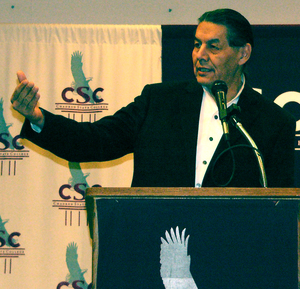Speaker says Crazy Horse set the standard for leadership

One of the preeminent Crazy Horse scholars, Joseph Marshall III, told an audience of approximately 100 at Chadron State College on Tuesday night that the Lakota warrior set the standard for leadership.
Marshall said Crazy Horse was never defeated in battle with the United States military or a rival Indian tribe and remains a hero to many native people, including him.
The speaker said Crazy Horse was a simple man who struggled at times and was not perfect, but did the best he could with the gifts God had given him. He said, “We can learn from him and emulate him.”
Marshall said Crazy Horse was daring and reckless in battle and had many close calls, but was wounded only once.
“He pushed himself to the limits and let it all hang out,” the speaker stated. “But he could keep his cool in times of chaos.”
Marshall, who was born and raised on the Rosebud Reservation in south central South Dakota and now lives in Santa Fe, N.M., wrote “The Journey of Crazy Horse,” a biography from the Lakota viewpoint based largely on oral history. Another book, “The Power of Four: Crazy Horse on Leadership,” is due out in 2008.
The speaker said two horrendous incidents early in Crazy Horse’s life shaped his future. When the future warrior was approximately 13, he witnessed the Grattan attack on Conquering Bear’s camp and a year or so later came upon Little Thunder’s camp where Gen. William Harney and his troops had killed and mutilated women and children.
“These incidents affected him the rest of his life,” Marshall said. “How could they not?”
Shortly after witnessing the aftermath of the attack on Little Thunder’s camp, Crazy Horse went into the hills by himself on a vision quest. Marshall said a vision quest, filled with meditation and prayer, is a severe test of courage and patience and is not to be undertaken lightly.
Marshall said as he understands the vision that occurred, Crazy Horse saw a young warrior ride horseback out of a lake that was surrounded by hills or mountains. The warrior was attacked by arrows and bullets and eventually pulled from his horse.
The vision has been written about, discussed and analyzed for years, Marshall noted. He added that as a youth he heard elders, including his maternal grandfather, say they felt the vision led Crazy Horse to believe he would die young and may have been the reason the warrior generally led the charge in battles.
Marshall’s appearance at Chadron State was a prelude to the Mari Sandoz Heritage Society’s annual conference that is this weekend at CSC. The conference will focus on Sandoz’s book, “Crazy Horse, Strange Man of the Oglalas.”
Marshall said he read the book twice while he was in junior high school and that was his introduction to Crazy Horse through the written word.
“I was impressed with what she tried to do,” he said. “Nothing else that I have read (on the warrior) comes close to Mari Sandoz’s book about Crazy Horse. I have tried to read other books about Crazy Horse, but I have never been able to finish them.”
Marshall also said:
--Crazy Horse’s given name in Lakota more properly should be translated “His Horse is Crazy.”
--By no stretch of the imagination would Crazy Horse want to be labeled an American warrior as Dr. Stephen Ambrose did in his book, “Crazy Horse and Custer.” “What America stood for was what Crazy Horse fought against all of his adult life. Crazy Horse did not think of himself as an American.”
--Lewis and Clark were probably the first to “appoint” chiefs because they preferred to talk to a small number at a time. Crazy Horse probably did not consider himself to be a chief, wore plain clothing and never donned a feathered bonnet.
--Crazy Horse probably would not want to be carved on mountain. The Lakota way of maintaining memory is to pass it down through stories.
--He would agree with renaming Harney Peak because it lies “in the center of our world, the Black Hills,” and is named after the person who committed terrible atrocities against Little Thunder and his people.
Category: Campus Events, Campus News
